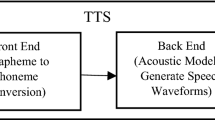Abstract
After total laryngectomy the normal voice can be replaced by an electronic artificial larynx (AL). However, the results of the surrogate voice are not overall satisfying due to a robotic clattered sound of that prosthesis. In this paper the outcome of a sound investigation for an AL is presented. This work is part of our AL research project on laryngectomee speech enhancement. As a result, an autoregressive model of the hearing process is derived that can directly be used for a novel speech-enhancement procedure. The model is derived in the framework of linear prediction theory based on the fact that speech can be modelled as the output of a linear filter excited by a periodic pulse train and random noise. Additionally, we developed an innovative training unit for novice laryngectomees measuring the relative inter-line energy of the speech.
Similar content being viewed by others
References
Buzug, T.M. and Pfister, G. (1992). Comparison of algorithms calculating optimal embedding parameters for delay-time coordinates. Physica D, 58:127–137.
Fant, G. (1960). Acoustic Theory of Speech Production. Gravenhage, Netherlands: Mounton and Co.
Grassberger, P. and Procaccia, I. (1983). Characterization of strange attractors. Phys. Rev. Lett., 50:346–369.
Itakura, F. (1975). Minimum prediction residual principle applied to speech recognition. IEEE Trans. Acoust. Speech Signal Proces, 23:67–72.
Lee, M.H. and Kaveh, M. (1986). Fast hadamar transform based on a simple matrix factorization. IEEE Trans. Acoust., Speech, Signal Processing, 34:1666–1667.
Lindgren, A.C. (2003). Speech recognition using features extracted from phase space reconstructions. Master Thesis, Marquette University, Milwaukee.
Ljung, L. (1987). System Identification: Theory for the User. NJ: Prentice-Hall, pp. 278–280.
Marple, S.L. (1987). Digital Spectral Analysis with Applications. Englewood Cliffs, NJ: Prentice-Hall.
National Cancer Institute, http://www.nci.nih.gov/cancertopics/wyntk/larynx.
Press, W.H., Flannery, B.P., Teukolsky, A.A. and Vetterling, W.T. (1988). Numerical Recipies in C; The Art of Scientific Computing. Cambridge University Press.
Rabiner, L. and Juang B.H. (1993). Fundamentals of Speech Recognition. Englewood Cliffs, NJ: Prentice-Hall.
Sambur, M. and Jayant, N. (1976). LPC analysis/Synthesis from speech inputs containing quantizing noise or additive white noise. IEEE Trans. Acoust. Speech Signal Proces, 24:488–494.
Schafer, R.W. and Rabiner, L.R. (1975). Digital representations of speech signals. Proceedings of the IEEE, 63:662–677.
Strothjohann, M. and Buzug, T.M. (2004). Klangbeurteilung bei elektronischen Sprechhilfen für Kehlkopflose. Biomedizinische Technik, 49:298–299.
Takens, F. (1980). Detecting Strange Attractors in Turbulence. Lecture Notes in Math. 898. Berlin: Springer-Verlag, pp. 366–381.
Author information
Authors and Affiliations
Corresponding author
Rights and permissions
About this article
Cite this article
Buzug, T.M., Strothjohann, M. Clatter Reduction for Electronic Artificial Larynx. Int J Speech Technol 8, 271–281 (2005). https://doi.org/10.1007/s10772-006-6892-1
Received:
Revised:
Accepted:
Published:
Issue Date:
DOI: https://doi.org/10.1007/s10772-006-6892-1




